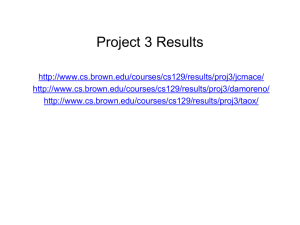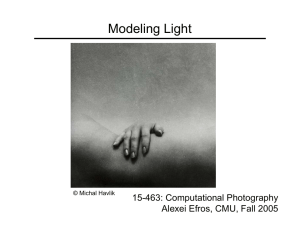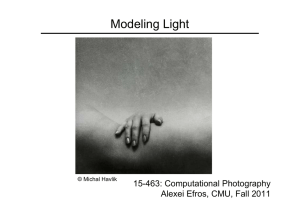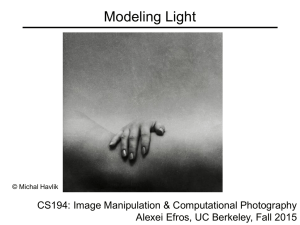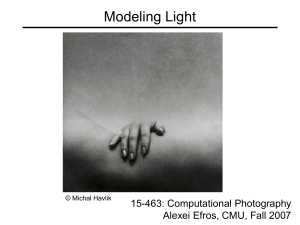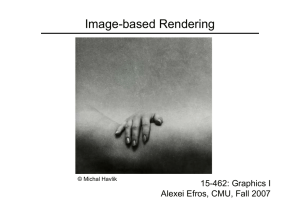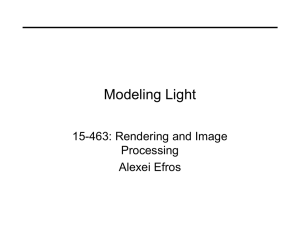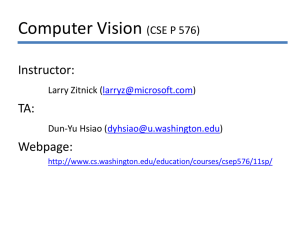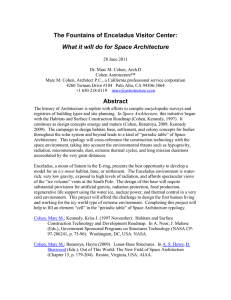Modeling Light 15-463: Computational Photography Alexei Efros, CMU, Fall 2008 © Michal Havlik
advertisement
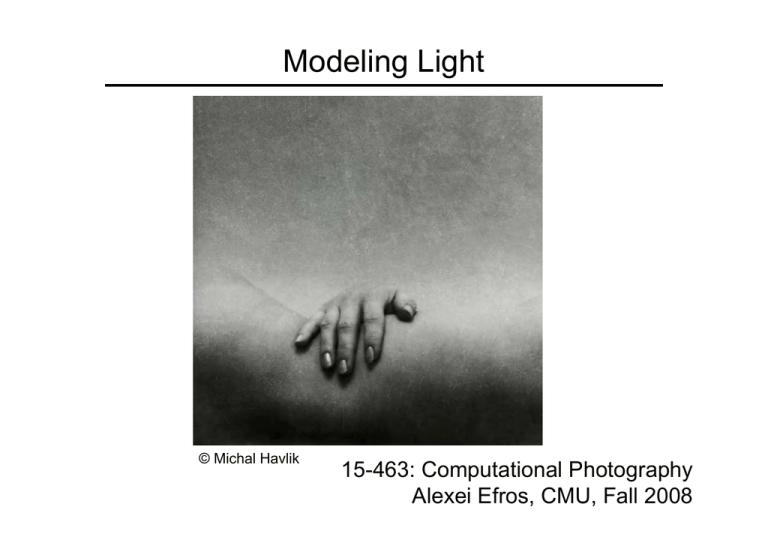
Modeling Light © Michal Havlik 15-463: Computational Photography Alexei Efros, CMU, Fall 2008 What is light? Electromagnetic radiation (EMR) moving along rays in space • R(λ) is EMR, measured in units of power (watts) – λ is wavelength Useful things: • Light travels in straight lines • In vacuum, radiance emitted = radiance arriving • i.e. there is no transmission loss What do we see? 3D world 2D image Point of observation Figures © Stephen E. Palmer, 2002 What do we see? 3D world Painted backdrop 2D image On Simulating the Visual Experience Just feed the eyes the right data • No one will know the difference! Philosophy: • Ancient question: “Does the world really exist?” Science fiction: • Many, many, many books on the subject, e.g. slowglass from “Light of Other Days” • Latest take: The Matrix Physics: • Slowglass might be possible? Computer Science: • Virtual Reality To simulate we need to know: What does a person see? The Plenoptic Function Figure by Leonard McMillan Q: What is the set of all things that we can ever see? A: The Plenoptic Function (Adelson & Bergen) Let’s start with a stationary person and try to parameterize everything that he can see… Grayscale snapshot P(θ,φ) is intensity of light • Seen from a single view point • At a single time • Averaged over the wavelengths of the visible spectrum (can also do P(x,y), but spherical coordinate are nicer) Color snapshot P(θ,φ,λ) is intensity of light • Seen from a single view point • At a single time • As a function of wavelength A movie P(θ,φ,λ,t) is intensity of light • Seen from a single view point • Over time • As a function of wavelength Holographic movie P(θ,φ,λ,t,VX,VY,VZ) is intensity of light • Seen from ANY viewpoint • Over time • As a function of wavelength The Plenoptic Function P(θ,φ,λ,t,VX,VY,VZ) • Can reconstruct every possible view, at every moment, from every position, at every wavelength • Contains every photograph, every movie, everything that anyone has ever seen! it completely captures our visual reality! Not bad for a function… Sampling Plenoptic Function (top view) Just lookup -- Quicktime VR Ray Let’s not worry about time and color: P(θ,φ,VX,VY,VZ) 5D • 3D position • 2D direction Slide by Rick Szeliski and Michael Cohen How can we use this? Lighting No Change in Radiance Surface Camera Ray Reuse Infinite line • Assume light is constant (vacuum) 4D • 2D direction • 2D position • non-dispersive medium Slide by Rick Szeliski and Michael Cohen Only need plenoptic surface Synthesizing novel views Slide by Rick Szeliski and Michael Cohen Lumigraph / Lightfield Outside convex space Empty 4D Stuff Slide by Rick Szeliski and Michael Cohen Lumigraph - Organization 2D position 2D direction θ s Slide by Rick Szeliski and Michael Cohen Lumigraph - Organization 2D position 2D position u s 2 plane parameterization Slide by Rick Szeliski and Michael Cohen Lumigraph - Organization 2D position 2D position s,t t u,v s,t v u,v 2 plane parameterization s u Slide by Rick Szeliski and Michael Cohen Lumigraph - Organization Hold s,t constant Let u,v vary An image s,t u,v Slide by Rick Szeliski and Michael Cohen Lumigraph / Lightfield Lumigraph - Capture Idea 1 • Move camera carefully over s,t plane • Gantry – see Lightfield paper s,t u,v Slide by Rick Szeliski and Michael Cohen Lumigraph - Capture Idea 2 • Move camera anywhere • Rebinning – see Lumigraph paper s,t u,v Slide by Rick Szeliski and Michael Cohen Lumigraph - Rendering For each output pixel • determine s,t,u,v • either • use closest discrete RGB • interpolate near values s u Slide by Rick Szeliski and Michael Cohen Lumigraph - Rendering Nearest • closest s • closest u • draw it Blend 16 nearest • quadrilinear interpolation s u Slide by Rick Szeliski and Michael Cohen Stanford multi-camera array • 640 × 480 pixels × 30 fps × 128 cameras • synchronized timing • continuous streaming • flexible arrangement Light field photography using a handheld plenoptic camera Ren Ng, Marc Levoy, Mathieu Brédif, Gene Duval, Mark Horowitz and Pat Hanrahan Conventional versus light field camera © 2005 Marc Levoy Conventional versus light field camera uv-plane st-plane © 2005 Marc Levoy Prototype camera Contax medium format camera Kodak 16-megapixel sensor Adaptive Optics microlens array 125μ square-sided microlenses • 4000 × 4000 pixels ÷ 292 × 292 lenses = 14 × 14 pixels per lens Digitally stopping-down Σ Σ • stopping down = summing only the central portion of each microlens © 2005 Marc Levoy Digital refocusing Σ Σ • refocusing = summing windows extracted from several microlenses © 2005 Marc Levoy Example of digital refocusing © 2005 Marc Levoy Digitally moving the observer Σ Σ • moving the observer = moving the window we extract from the microlenses © 2005 Marc Levoy Example of moving the observer © 2005 Marc Levoy Moving backward and forward © 2005 Marc Levoy 3D Lumigraph One row of s,t plane • i.e., hold t constant s,t u,v 3D Lumigraph One row of s,t plane • i.e., hold t constant • thus s,u,v • a “row of images” s u,v P(x,t) by David Dewey 2D: Image What is an image? All rays through a point • Panorama? Slide by Rick Szeliski and Michael Cohen Image Image plane 2D • position Spherical Panorama See also: 2003 New Years Eve http://www.panoramas.dk/fullscreen3/f1.html All light rays through a point form a ponorama Totally captured in a 2D array -- P(θ,φ) Where is the geometry??? Other ways to sample Plenoptic Function Moving in time: • Spatio-temporal volume: P(θ,φ,t) • Useful to study temporal changes • Long an interest of artists: Claude Monet, Haystacks studies Space-time images Other ways to slice the plenoptic function… t y x The “Theatre Workshop” Metaphor (Adelson & Pentland,1996) desired image Painter Lighting Designer Sheet-metal worker Painter (images) Lighting Designer (environment maps) Show Naimark SF MOMA video http://www.debevec.org/Naimark/naimark-displacements.mov Sheet-metal Worker (geometry) Let surface normals do all the work! … working together clever Italians Want to minimize cost Each one does what’s easiest for him • Geometry – big things • Images – detail • Lighting – illumination effects
